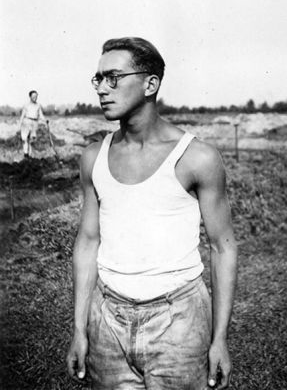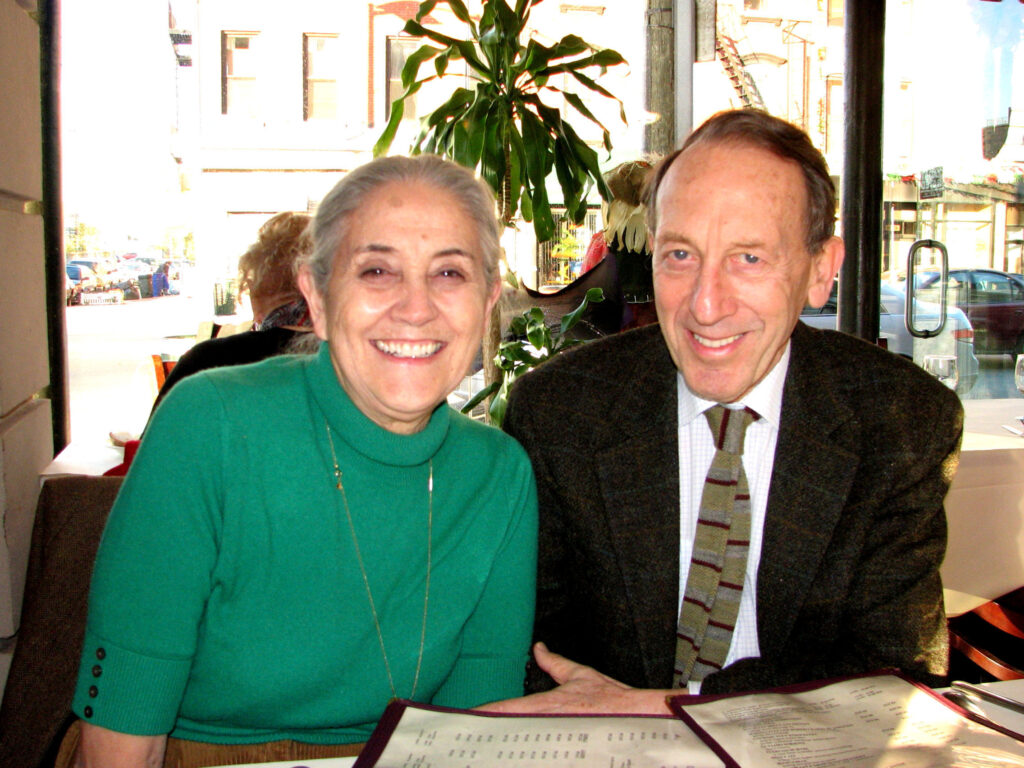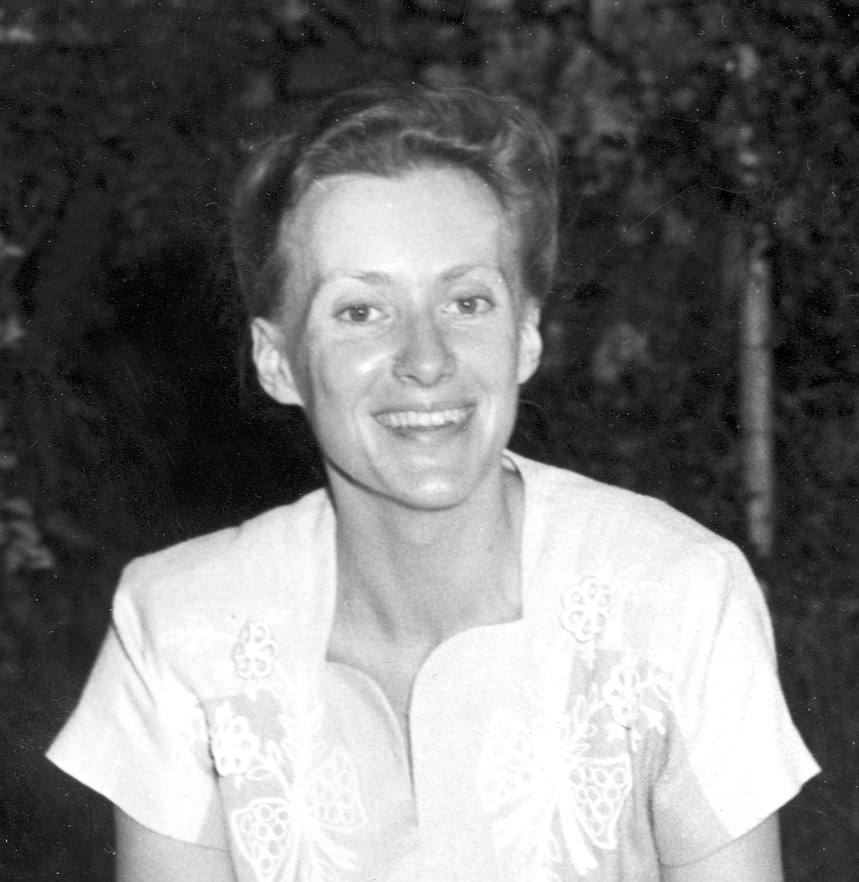
Philip “Flip” Slier
Flip, born on December 4, 1923, in Amsterdam, was the only child of Leendert “Eliazar” Slier and Seline Rosette Salomonson. They lived at 128 Vrolik Street where his letters were found in 1997 when the house was being demolished—55 years after Flip’s parents had hidden them above the ceiling of the third-floor bathroom.
When the Germans invaded Holland in 1940, Flip was a 17-year-old apprentice typesetter at the daily Amsterdam newspaper, Algemeen Handelsblad. He was just under five feet eight inches tall and weighed 156 pounds. He was an agreeable and gregarious young man with a good sense of humor. He played the flute and mandolin and enjoyed singing. He was also a keen photographer and a number of the photographs in Hidden Letters were taken by Flip himself.
From his first letter to his parents, written on April 25, 1942, to the last known letter on September 14, 1942, Flip wrote of the trials and tribulations at Camp Molengoot as well as the incredible kindnesses of people who helped him. In the heat, cold, rain, and mud, Flip filled wheelbarrows with earth and sand. The work was physically exhausting even for a young man, and the meager diet he was given did not satisfy his constant hunger. Flip describes his coworkers as pleasant, honest, and loyal to one another. They cooperated to forage for food from local farmers and shared their spoils.
Flip’s letters testify to both his optimism and his fear. He expresses his hope to be reunited with his parents and his gratitude to the extended network of support he received from friends, relatives, and complete strangers, Jews and Gentiles. He writes about everyday problems, his concern for his girlfriend and his discovery of a good-looking local farmer’s daughter, the problem of getting extra food, of earning more money, and how to keep their spirits up as the Nazi noose tightened. He writes about how best to avoid deportation or to best cope with deportation.
Flip writes philosophically about life. “What is a person? What is all of life? Nothing. And still we don’t want to lose it, and that is why we have to be strong and have faith. Someday we will be liberated!!! I am sure of that.”
After writing the last of these letters, Flip escaped from Molengoot, dyed his hair, obtained false papers, and went into hiding. We know that he was reunited with his friend Karel van der Schaaf and visited family and friends. He worked and hid in a restaurant behind the Amstel Hotel.
After almost six months in hiding, Flip was arrested at Amsterdam’s Central Station for failing to wear a Jewish star. He was sent to Vught concentration camp sixty miles south of Amsterdam and from there to S-Hut 67, the punishment barrack at Westerbork. He arrived at the Sobibor on April 9, 1943. His parents, who were also sent to Westerbork, arrived in Sobibor on June 4, 1943. Flip and his parents were killed there along with 250,000 other men, women, and children.

Deborah Slier and Ian Shine
Deborah Slier’s father emigrated from Holland to South Africa in 1922. She was born and grew up in Johannesburg where she learned that the Nazis held no patent on intolerance and persecution.
Deborah Slier and Ian Shine, co-editors and co-annotators of Hidden Letters, have lived in England, Hawaii and on the Island of St Helena in the South Atlantic Ocean, where Ian was the island doctor. They now live in Massachusetts.
In 1968, Deborah Slier founded and managed the Owl and the Pussycat children’s bookstore in Lexington, Kentucky. She later worked as an editor for Penguin Books, Random House, and Macmillan. In 1994, she established Star Bright Books in New York City.
Ian Shine was born in England. Educated at Cambridge, he worked as an MD while teaching and authoring two books on genetics, Serendipity in St. Helena and Thomas Hunt Morgan: Pioneer in Genetics. He has spent much of his time engaged in medical research, patenting several novel analytical techniques. He is coauthor of a forthcoming book, A Bloody History of the Twentieth Century
In 1999, Deborah received the material on which this book is based. The letters and postcards from her first cousin Philip “Flip” Slier to his parents in Amsterdam tell of his daily life imprisoned at Molengoot forced labor camp. Deborah’s father, Jack, and Flip’s father, Eliazar, were brothers.
After reading Flip’s letters, Deborah began to add documents and photographs to help her better understand conditions in Holland under the German occupation. Her own memories of that time are of her mother weeping as she listened to the radio news that announced the Germans had invaded their beloved Holland, a large map her father kept on the dining room wall on which the family followed the course of the war, and her father weeping when the Red Cross informed him that virtually no one in his family had survived the war.
For both Deborah and Ian, one of the most gratifying aspects of this project was meeting the Dutch people who touched Flip Slier’s life, especially Karel van der Schaaf, who married Flip’s girlfriend after the war. Deborah and Ian have been deeply touched by the efforts of Good Samaritans, such as Karel and the Vrijlink family, whose personal sacrifices and willingness to take risks helped Flip and others survive.
Deborah and Ian have added photographs, documents, and notes that explain Flip’s allusions, relations, friends, and the circumstances of the time. They also found Flip’s fingerprint on one of his letters. Through their friendship with Karel van der Schaaf, Tooje Loonstijn-Renger, and Alice van Keulen-Woudstra, they learned many details that in themselves were small, but cumulatively helped to make Flip and his circle come alive.

Marion van Binsbergen-Pritchard
Hidden Letters translator Marion van Binsbergen-Pritchard was born in the Netherlands. Marion was an ideal translator of Flip’s letters because she has been bilingual from birth; her mother was English and her father Dutch.
Marion van Binsbergen-Pritchard was born in 1920, three years before Flip Slier. She lived in Holland throughout World War II; for most of that time she was a young adult student living in Amsterdam.
After the war, Marion worked in a United Nations Relief and Rehabilitation Administration camp helping refugees. There she met and married another camp worker, an American, Tony Pritchard.
After their marriage, Marion and her husband moved to the United States. She now lives in Washington, D.C.
In 1981, Yad Vashem recognized her heroic efforts to rescue about 150 Jews by awarding her a medal. She has also earned a Raoul Wallenberg Award.
Marion is a retired psychoanalyst and former educator teaching Holocaust studies at Clark University. She was profiled by U.S. News & World Report as one of the fifty heroes of the 20th century. Marion continues to lecture on the Holocaust and its Jewish and non-Jewish heroes.
For more biographical information, see Rescuers: Portraits of Moral Courage in the Holocaust by Gay Block and Malka Drucker (Holmes and Meier, 1992). Also see, Holocaust Rescuers: Ten Stories of Courage by Darryl Lyman (Enslow, 1999).
